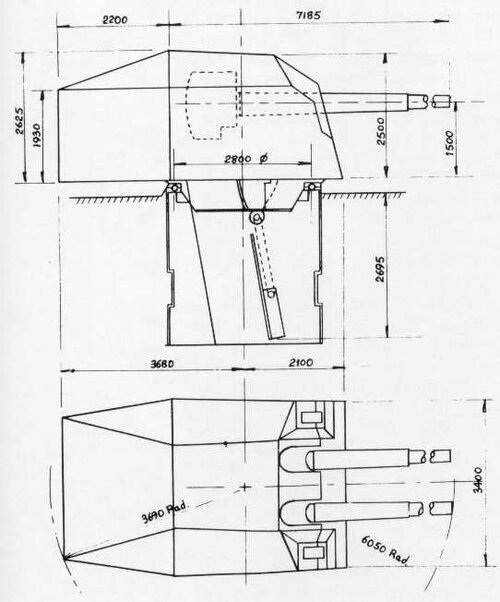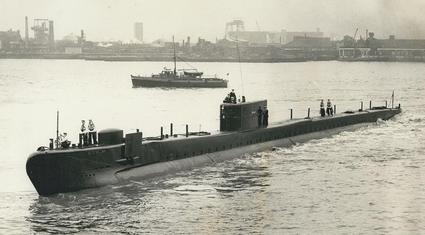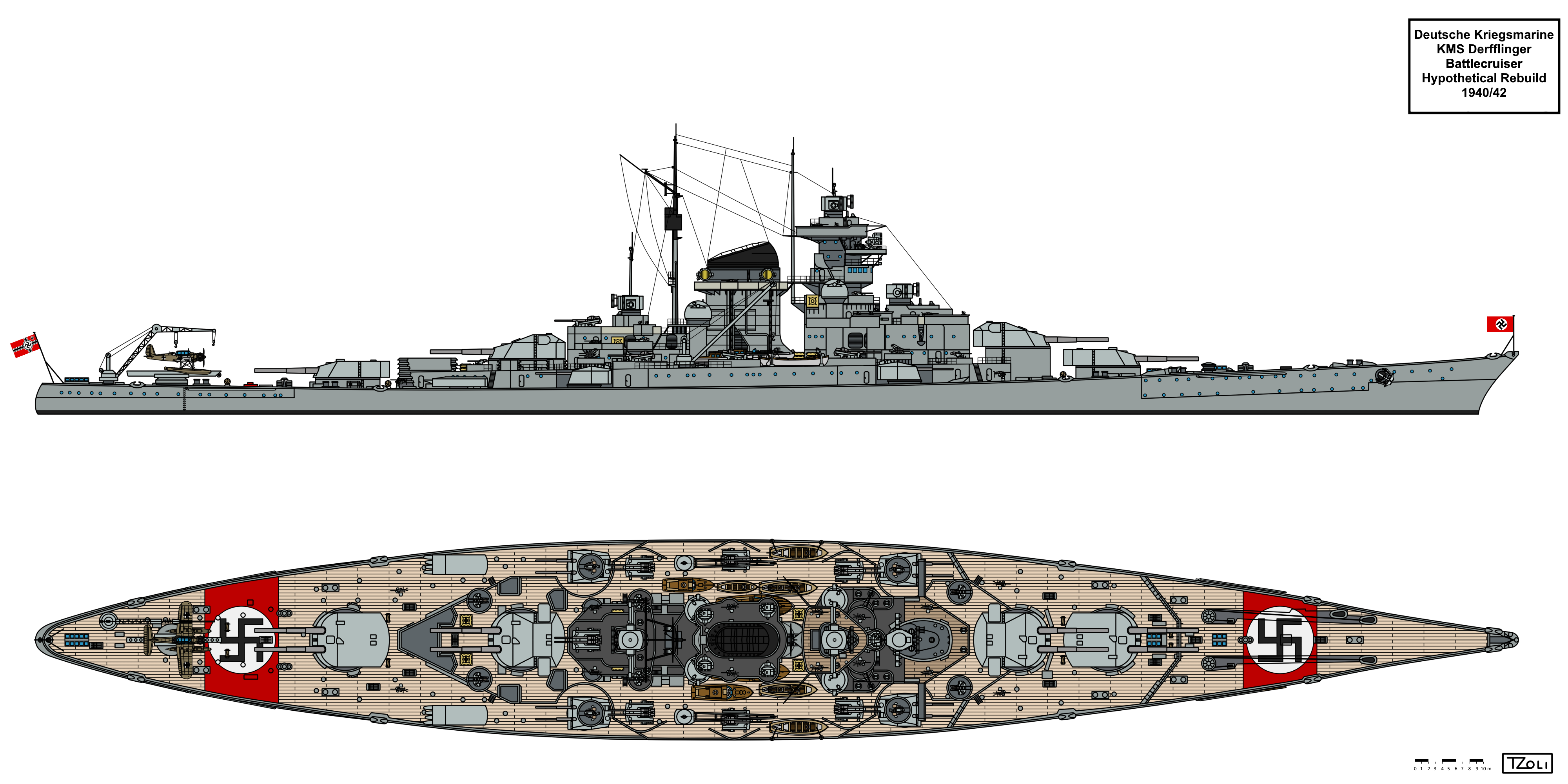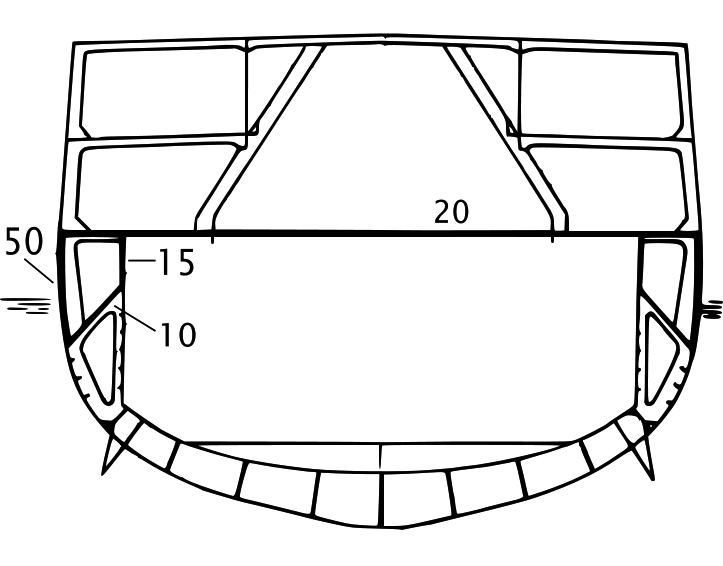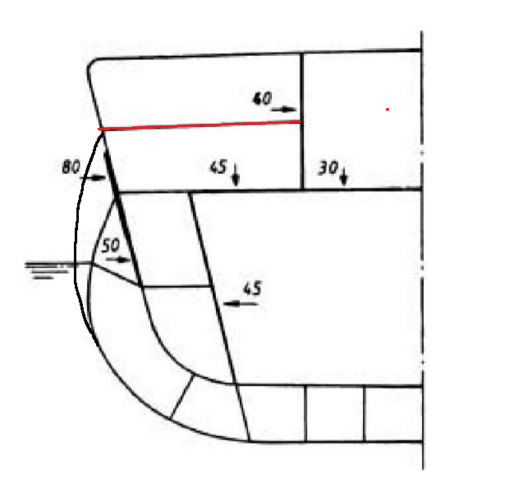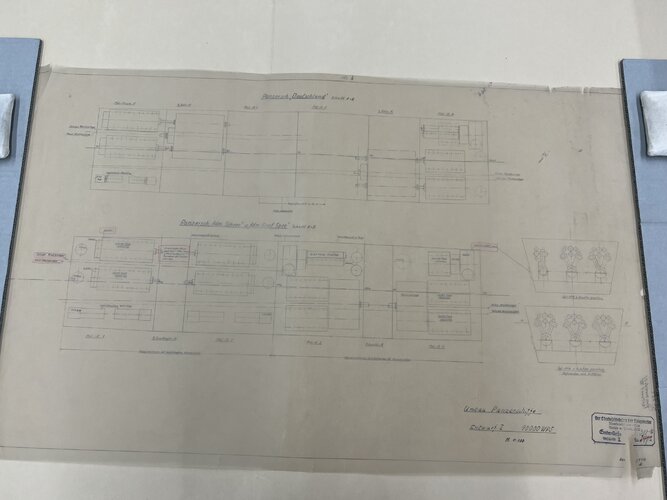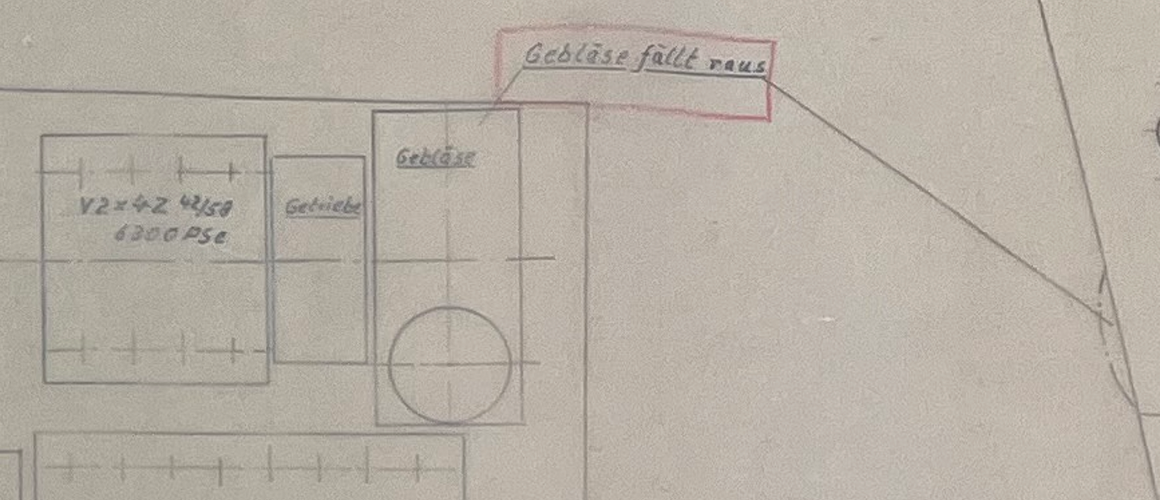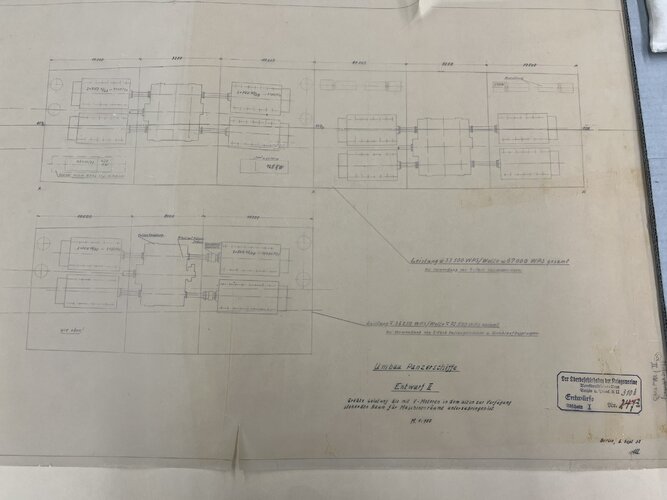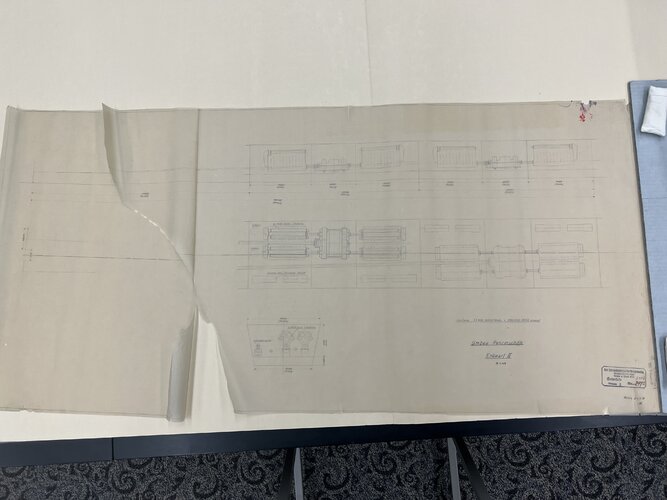_Sarcasticat_
Die Katze.
- Joined
- 16 April 2020
- Messages
- 319
- Reaction score
- 264
I just wanted to share this bit of interesting information with the rest of you since I had it pop up in recent conversation with one of my other naval circles.
The Breyer Proposal

What we're looking at here is a page coming from the 1970 first-print copy of Siegfried Breyer's Battleships and Battle Cruisers 1905-1970. What we're looking at specifically here is Gneisenau, "Modification Project 1942/43, made according to official records". Note the use of the word "records". This does not say "plans", "images", "sketches", or any other form of drawing, but written records.
So...what is so special about this drawing of Gneisenau?
What makes this particular rendition of Gneisenau's 38cm rebuild so interesting is that it takes a stab at depicting the short-lived plan to provide a unified (single-caliber) Dual-Purpose secondary battery for the ship, replacing the split 15cm/10.5cm secondary gun battery. This is perhaps the earliest attempt at doing so and provides a unique, if incorrect, depiction.
Unified-caliber dual-purpose secondary batteries had gained some amount of traction as early as the late 1930's, as far as I can tell, with the planned Deutschland rebuilds. This rebuild, planned for all three Deutschland-class ships, called for dual-purpose 128mm guns to replace the 15cm/55 singles and 10.5cm twins (the type and number of these 128mm guns is unknown***). More concretely, in 1941 there was also the suggestion of a unified 128mm DP secondary battery for H41 in place of her standard secondary battery (6x2 15cm/8x2 10.5cm). Again, number and type are unknown. This can be found in RM6 if you want to go searching for it.
And, of course, we have the somewhat well-known Gneisenau conversion to 128mm DP guns plan.
For Breyer's interpretation, he has decided to use the 128mm/45 SK C/41 in Drhl C/41 twin turret, developed and prototyped in 1941, therefore replacing the 15cm/55 and 10.5cm twin turrets on a 1-for-1 basis for 11 turrets total. He also took the liberty of upgrading the AA and adding a small tactical radar on the tripod mast aft of the smokestack.
The issue with Breyer's depiction is that he appears to have had very little information to work with - likely just the caliber and number of guns - or in the case of the secondary battery, just caliber - leading to the necessity of making his own version of the project based on the written information he had. You can tell by the out-of-standard placement of the 2cm singles, the fact the tripod mast has no been moved aft (to match Scharnhorst), or even the use of the 128mm SK C/41. If you do not believe me, then by his own admission in the 1978 reprint of the book featuring numerous corrections and alterations, one of which is the removal of the old Gneisenau image above with the one below, as well as the following words:

"[In terms of upgrading only so far as the 38cm guns and 2cm AA] ...Any information to the contrary concerning the conversion of Gneisenau has not stood up to more recent rechecking and is therefore incorrect."
A strange way of admitting you fucked up and made a fictional fan-drawing, but sure enough this drawing does depict design K235/N4 for Gneisenau, created in 1942 and nowadays given the archive code of RM 25/15788:
While it may be true that K235/N4 does not feature an altered secondary battery, that is not all there is to the story. In fact, there was actually a plan to replace the secondary battery with DP 128s. Garzke and Dulin's Axis and Neutral Battleships of World War II (not the best authors or most accurate book by any means, but still a generally good source) references this, stating the intention of the study was to source "recently developed" "127mm guns"* (this can reasonably be assumed to only mean the 128mm/61 Flak 40, as it entered production in mid/late 1941, and not the 128mm/45 SK C/41 as the latter would not face the issue of being claimed by other branches on grounds of priority, mainly because it is a weapon developed specifically for naval service) for use on Gneisenau, but the Heer and Luftwaffe claimed priority on the weapons - which were in very short supply, with only 1 being produced per month until mid-1944 - ending the idea almost as soon as it began.
In short, Breyer was incorrect yet again - and this, kids, is why you don't say anything with absolute certainty in a field where there is so much information yet to be released.
* = 12.7cm and 12.8cm were interchangeable in sources of the Wehrmacht, but actual bore diameter of most (if not all) German domestic production 5" caliber guns was 12.8cm.
Still, despite not having Flak 40 guns, to discredit the technical plausibility of the refit is wrong. Why is that? Let's discuss, but first: a developmental history of the gun in question:
"A Short Developmental History of the SK C/41 with Statistics":
In 1941 (thus proving that the KM was aware of and wanting the Flak 40 before 1942), a Flakzwilling 40 (Flakzwilling 40/2 or 42, depending on source) was returned to Rheinmetall-Borsig A.G. (the designer and producer of the Flak 40) so that the barrels could be changed out for shorter 45-caliber models capable of firing the 128mm/45 SK C/34's naval ammunition for use in turrets based on the Drhl C/38 twin. By the end of testing, the barrels had been shortened by just 30mm, the rifling to changed (to 1.7mm x 5.05mm versus 1.5mm x 6.0mm [SK C/34] and 1.7mm x 6.55mm [Flak 40]), and the mount lightened and decreased in size (most notably the guns placed much closer together for use in the new turret that was also designed in parallel with the gun: the Drhl C/41 twin). It is this gun that would be the 128mm/45 SK C/41.
The 128mm/45 SK C/41 is a semi-automatic, manually operated horizontal sliding wedge design with a lined barrel of 40 grooves (same as Flak 40) 1.7mm deep and 5.05mm wide. The gun is fired by an electromagnetic method with a backup mechanical firing system, features a brake hydraulic recoil cylinder + pneumatic knurler, and is loaded by an electric rammer. Horizontal and vertical guidance was also electrical. Also attached to the mount was a fuze-setting device. Most of these features are shared with the Flak 40.
Each gun weighed 4250kg, had an o/a length (includes breech) of 5807mm, barrel body length of 5400mm, and a rifling length of 4547mm. Working pressure is 2950 kg/cm2.
The "technical" rate of fire for these guns is 18 RPM per gun. In field tests with the Flakzwilling 40, rates of fire from a trained crew reached as high as 28-30 RPM per mount (14-15 RPM per gun). This is all well and dandy, but everyone tends to conveniently ignore the other factors, such as the rate of supply, endurance and training of the loaders, and operating environment (which would not be friendly on a rolling and pitching small destroyer turret).
The rounds fired are those from the SK C/34, pressed into a different cartridge and do not match that fired by the Flak 40. The ammunition is unitary. The two rounds are:
The ammunition for the Flak 40 is as follows:
Both AA ammunition types are quite impressive, featuring good muzzle velocity (800+ m/s) and packing over 7 pounds of explosive filler, putting it's explosive weight on par with USN 5"/38 AAC rounds.
The Drhl. C/41 turrets are scaled down Drhl. C/38 twins and serve to lighten the turret both by making it smaller and reducing the armor to just 8mm (sides) - 10mm (face). On the Type 1936A/36A Mob ships, the armor for the Drhl. C/38 was 20mm (sides) - 30mm (face), however the weight reduction is apparent, going from 60.4t (occasionally 62t depending on source) to 40.5t. The guns were placed in a single cradle, and the reduction between the guns from 2325mm (Flak 40) to just 1500mm (C/41) caused a limited elevation of just 52 degrees - a downgrade from the Drhl. C/38's 62 degrees. Additional problems may be faced as the Drhl. C/38 faced issues with keeping water out of the turret, which had caused electrical shorts and faults. The addition of more electronics (such as the rammer) may exacerbate this issue if the mount is not sufficiently weatherproofed.
/end
With the 128mm/45 SK C/41 theoretically ready for tooling and then full production by 1942, it only became an issue with where to put the newly designed weapons. Of course, almost all new destroyer designs from 1941 and onwards would feature the new turret - it was designed for them, after all - but, as most know, only 2 of the designs that would feature it were ever even laid down, and nearly at war's end to boot, ensuring that demand for the production of the system remained low. The same issue was faced with the Drhl. C/38 for the 15cm/48 TK C/36, in design since 1937 (and presumably first constructed in 1938, hence "C/38") it did not reach service until 1942 as most of the designs that might have included it were cancelled (due to the outbreak of the war or in favor of another class) until the refits of the 1936A and the laying down of the Type 1936A (Mob) types.
Of course, that never stopped naval architects from drawing and designing, and with her planned rebuild in 1942-43, Gneisenu is in the perfect position to get the Drhl. C/41. Being essentially a Kriegsmarine-tailored Flakzwilling 40, the KM could now, basically, get the Flakzwilling 40 for their own "domestic" ends without having to fight the Heer and Luftwaffe (both much higher priority branches) for it.
But after this, it sort-of falls apart.
While there are a few Pros to this sort of idea (The ability to fit 16.66 [16] C/41 twins for the same weight as Gneisenau's original secondary battery, the AA-capable performance of all mounts, powered loading, a fully enclosed turret, etc) the cons come to bite much harder:


The P.1000 Ratte mockup as of October 1942, clearly showing the SK C/41 in Drhl. C/41.
In conclusion: There are better alternatives. The 128mm/45 SK C/41 and its turret are good in a pinch if it was the only option available, but there would have to be a concerted effort to get production rolling and an acceptance that, in a combat situation, these turrets are highly vulnerable and may not perform as expected.
Speaking of alternatives.
Most even slightly familiar with Kriegsmarine design will more than likely at least be aware of WarGaming's tier 7 battleship Gneisenau from World of Warships, so, while we're here, why not discuss that too?
The WarGaming Model
Gneisenau in WoWs, represented by the "B" hull, features 11* Drhl. C/38 twin turrets. These turrets, designed for the larger 15cm/48 TK C/36, have been re-armed with the 128mm/61 "KM40" (Flakzwilling 40). In addition to the alterations to the secondary battery, WG have also re-arranged the superstructure and enhanced the AA in their typical way (that is, to say, badly).
In spite of that, the concept of WarGaming's Gneisenau secondary battery refit model is actually much better than what your typical elitist would give it credit for, the very same who would scoff at even the thought that a WG creation might have been decent - and to be honest, it's not entirely undeserved, but this is one of those exceptions.
...Wait, what are you doing with that pitchfork and torch? Wait, I'm sorry! Put it down! I'll apologi- screaming
* = Gneisenau could accommodate a maximum of 14.7 (15) 128mm/61 KM40 in Drhl. C/38 turrets for approximately the same total weight as the 15cm and 10.5cm turrets they replace.
So why is this WarGaming version of the Gneisenau 128 DP secondary battery "good"? This design matches the assumed gun type and thus meets the most basic criteria, automatically putting it ahead of the Breyer Proposal, but before we get to the core reasons why, let's discuss the Pros and Cons of using this gun and turret combination:
Pros:

Cons:
As you can see, the Pros certainly outweigh the Cons, much more so than the 128mm SK C/41 used in the Breyer Proposal, and even the Cons are not things that cannot be overcome with some minor edits (with the exception of triaxial stability or the making of holes in the decks). Even if the weight savings obtained by using the KM40 over the 15cm/48 TK C/36 (Drhl. C/38 w/ KM40 = 52.87t vs 60.4t with 15cm/48) was eaten up entirely, one could still replace the entire secondary battery 1-for-1 and still only break even.
In conclusion: It is the perfect design for the Kriegsmarine in a pinch if they got their hands on the F.Z. 40 for Gneisenau, according to plan - "Kriegsmarine in a pinch" pretty much describing the KM ever since the war broke out. Out of all the turret and gun options, it is the most rapidly sourced among them, requiring only minor modification, already in production, and all-around well-suited for DPAA work as a secondary weapon compared to the 128mm SK C/41.
For the Kriegsmarine, it's all about what could be sourced quickly - there's a war on (or if 1938/39, would be very soon), and you have to use what you have, even if it isn't the best thing. Sometimes that begets creative and otherwise unorthodox solutions, but it generally will consist of things already in production. You will see this reflected in almost every German design from 1938 and on and is just part of the nature of the beast. So, as odd as it might sound, WG nailed their Gneisenau secondary battery refit on the head - and it looks good to boot.
But it's not the most optimal choice.
So what does the most "optimal" possible secondary refit look like? Here's my suggestion:
The Sarcasticat Proposal
A few of you probably already know where this is heading, but still, let's discuss.
So if the 12.8cm SK C/41 and Drhl. C/41 and the Drhl. C/38 turret are out of the picture for the F.Z. 40, what's left?
Well, during mid-to-late 1940 and early 1941 there was a series of high-elevation triaxial enclosed turret designs (read: big 10.5cm twin mount) for a "12.7cm Doppelflak L54". Upon closer inspection, it is obvious this is just a shorter 128mm Flakzwilling 40. Whether this is because the KM expected to shorten the 61-caliber barrel to reduce weight (most likely) or because at this time the length of the barrel has not been determined (less likely), it is still clear to see that, with the issue of production not forthcoming at the time, the KM figured that it would have access to a larger number of the 'intermediate caliber' weapons that underwent testing in 1938 and was nearing its final form in late 1940 and as such made a series of pre-emptive designs for twin turrets.
The name of these designs is unknown, but "LM40" is already taken, haven been given to the coastal mounts. Given the date of the final design we have being very early 1941, a prospective name might be "LM41". The guns had an elevation of +85 deg and could depress -10 deg, but other specifications (such as elevation/training speeds, weight, etc) are not known or were not created. However, one can guess that the weapon would be immensely weighty - upwards of 60t with train and elevation speeds somewhere in the ballpark of 10 deg/s. This is a design meant as a large secondary weapon.

The final rendition of the 12.7cm Doppelflak twin turret design, 22 January 1941. For those of you who find this turret familiar, you can find it on some high-tier German ships in WoWs (Preussen, Clausewitz, and Hannover, for example).
For Gneisenau this is about the best that would ever possibly be available - that we currently know of - and despite the unfavorable weight estimate the ship could still handle a 1-for-1 swap and break even with the original 15cm/10.5cm battery weight.
Let's discuss the Pros and Cons:
Pros:
As you can see there isn't a lot to write about because there isn't much that is known. In theory, if this is just an enlarged version of the 10.5cm with some additional features, one might expect to see similar levels of armor, comparable train and elevation rates (at least to the 10.5cm C/38 mount), and overall good performance - just at a larger scale. The main issue comes with production, but at least the design dates to 1940 (or latest known, Jan. 1941) which means that it has at least reached paper in a detailed form even if no prototype turrets were made (to our knowledge). However, there is no getting around this production issue (prototyping, tooling, etc) unless the turret has priority and it is certain the KM can attain the F.Z. 40 to mount to it, leaving this proposal dead last in terms of production potential - even the 128mm SK C/41 is slightly ahead due to finalized turret design, mount prototype, the like.
In conclusion: It's the most optimal and reasonable turret for the job, it just needs to get produced. But for 1942-going-on-43 Germany, that's quite a tall order, even if it was as simple as "make 10.5cm - but bigger".
Conclusion.
Some people on the internet say that the Drhl. C/38 turret is intended to be the stopgap measure until the triaxial mount ("LM40") (or perhaps LM44) could be produced, which, regardless of truth, makes the most sense when you think about it. In 1943 the C/38 is the only available HA turret or mount of any type that the Kriegsmarine has in production that could take the 12.8cm F.Z. 40/KM40 if they were to receive a batch that year. With the war tipping out of their favor and the disastrous Battle of the Barents Sea (31 Dec 1942) causing Hitler to call for a complete removal of all his capital ships (from existence), it suddenly becomes that much harder to substantiate the worth of getting such a complex turret as the "LM41"/LM44 on short notice. This is probably why only design work was underway when the war ended.
So in short that leaves us with this conclusion: The "LM41" is the most optimal turret, the C/38 is the most realistic and practical, and the SK C/41 is the choice the KM would make if they couldn't get their hands on the Flakzwilling 40 but still wanted to proceed with a secondary battery change.
But I guess K235/N4 trumps all of them because it's the only drawing we have on paper.
Well, maybe there are more drawings of proposed secondary battery changes, or more discussions in books somewhere, but we don't have those yet. Maybe one day.
Whew, another full day taken to revise this! Hope someone learned something.
The Breyer Proposal
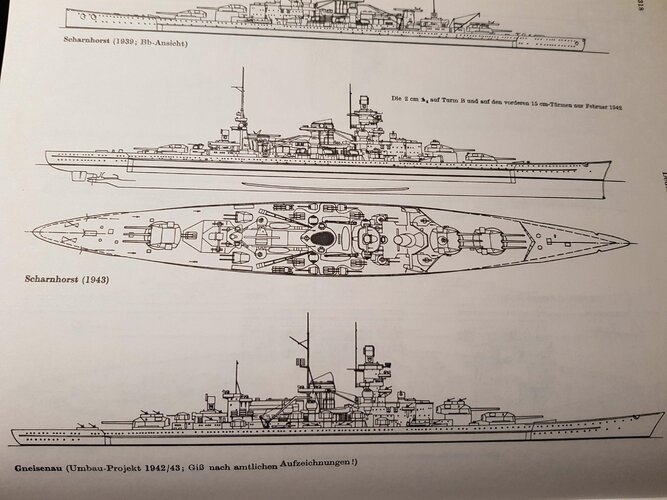
What we're looking at here is a page coming from the 1970 first-print copy of Siegfried Breyer's Battleships and Battle Cruisers 1905-1970. What we're looking at specifically here is Gneisenau, "Modification Project 1942/43, made according to official records". Note the use of the word "records". This does not say "plans", "images", "sketches", or any other form of drawing, but written records.
So...what is so special about this drawing of Gneisenau?
What makes this particular rendition of Gneisenau's 38cm rebuild so interesting is that it takes a stab at depicting the short-lived plan to provide a unified (single-caliber) Dual-Purpose secondary battery for the ship, replacing the split 15cm/10.5cm secondary gun battery. This is perhaps the earliest attempt at doing so and provides a unique, if incorrect, depiction.
Unified-caliber dual-purpose secondary batteries had gained some amount of traction as early as the late 1930's, as far as I can tell, with the planned Deutschland rebuilds. This rebuild, planned for all three Deutschland-class ships, called for dual-purpose 128mm guns to replace the 15cm/55 singles and 10.5cm twins (the type and number of these 128mm guns is unknown***). More concretely, in 1941 there was also the suggestion of a unified 128mm DP secondary battery for H41 in place of her standard secondary battery (6x2 15cm/8x2 10.5cm). Again, number and type are unknown. This can be found in RM6 if you want to go searching for it.
And, of course, we have the somewhat well-known Gneisenau conversion to 128mm DP guns plan.
* = Given the year of the planned rebuilds, the Drhl. C/38 turret - the shape, size, weight, and other dimensions completed by the time of the rebuild proposals - is the most likely choice for this (even if weight savings were not as high as expected). By the calculations I made you could get 5.5 (limited to 5 in reality) regularly armored (30mm face, 20mm sides) Drhl. C/38 twin turrets with 12.8cm/45 SK C/34 guns. These turrets would most likely be placed 2 to a side with one centerline aft, replacing the 10.5cm gun there. If this was done, there would have been a weight savings of 29.5 tonnes. If you were to de-armor the turrets for approximately 42-43t, you could get 6.6 turrets (6 with weight savings, 7 with a slight weight penalty) (3 to a side or 3 to a side with one centerline aft). Alternative armor arrangements for the turret have been considered before, the particular example in mind being the O-class (14mm), and of course the smooth-ified Drhl. C/38 for submarines is likely unarmored given the weight (42.2t). A small weight penalty could be allowed for as the ships were expected to increase upwards of 700t in their rebuilds.
For Breyer's interpretation, he has decided to use the 128mm/45 SK C/41 in Drhl C/41 twin turret, developed and prototyped in 1941, therefore replacing the 15cm/55 and 10.5cm twin turrets on a 1-for-1 basis for 11 turrets total. He also took the liberty of upgrading the AA and adding a small tactical radar on the tripod mast aft of the smokestack.
The issue with Breyer's depiction is that he appears to have had very little information to work with - likely just the caliber and number of guns - or in the case of the secondary battery, just caliber - leading to the necessity of making his own version of the project based on the written information he had. You can tell by the out-of-standard placement of the 2cm singles, the fact the tripod mast has no been moved aft (to match Scharnhorst), or even the use of the 128mm SK C/41. If you do not believe me, then by his own admission in the 1978 reprint of the book featuring numerous corrections and alterations, one of which is the removal of the old Gneisenau image above with the one below, as well as the following words:
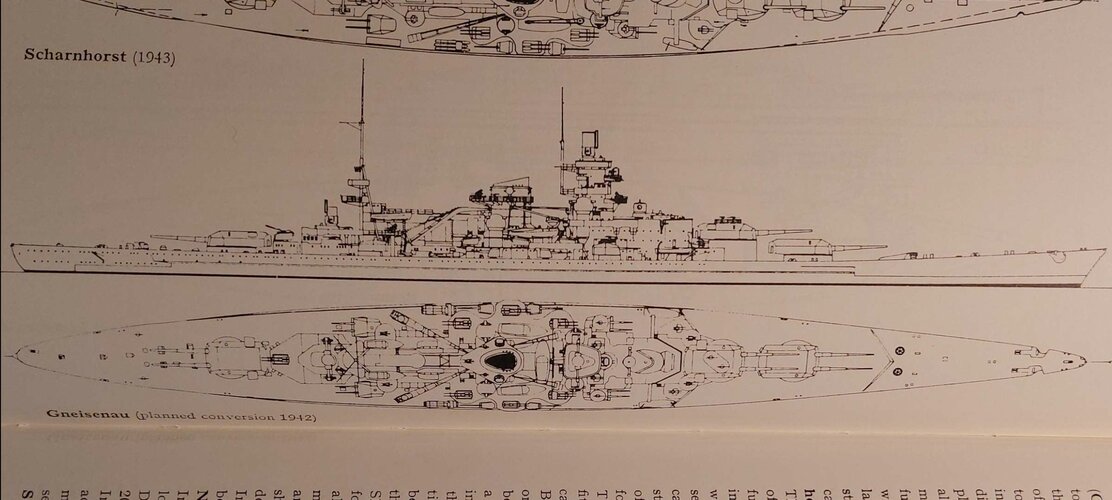
"[In terms of upgrading only so far as the 38cm guns and 2cm AA] ...Any information to the contrary concerning the conversion of Gneisenau has not stood up to more recent rechecking and is therefore incorrect."
A strange way of admitting you fucked up and made a fictional fan-drawing, but sure enough this drawing does depict design K235/N4 for Gneisenau, created in 1942 and nowadays given the archive code of RM 25/15788:
While it may be true that K235/N4 does not feature an altered secondary battery, that is not all there is to the story. In fact, there was actually a plan to replace the secondary battery with DP 128s. Garzke and Dulin's Axis and Neutral Battleships of World War II (not the best authors or most accurate book by any means, but still a generally good source) references this, stating the intention of the study was to source "recently developed" "127mm guns"* (this can reasonably be assumed to only mean the 128mm/61 Flak 40, as it entered production in mid/late 1941, and not the 128mm/45 SK C/41 as the latter would not face the issue of being claimed by other branches on grounds of priority, mainly because it is a weapon developed specifically for naval service) for use on Gneisenau, but the Heer and Luftwaffe claimed priority on the weapons - which were in very short supply, with only 1 being produced per month until mid-1944 - ending the idea almost as soon as it began.
In short, Breyer was incorrect yet again - and this, kids, is why you don't say anything with absolute certainty in a field where there is so much information yet to be released.
* = 12.7cm and 12.8cm were interchangeable in sources of the Wehrmacht, but actual bore diameter of most (if not all) German domestic production 5" caliber guns was 12.8cm.
Still, despite not having Flak 40 guns, to discredit the technical plausibility of the refit is wrong. Why is that? Let's discuss, but first: a developmental history of the gun in question:
"A Short Developmental History of the SK C/41 with Statistics":
In 1941 (thus proving that the KM was aware of and wanting the Flak 40 before 1942), a Flakzwilling 40 (Flakzwilling 40/2 or 42, depending on source) was returned to Rheinmetall-Borsig A.G. (the designer and producer of the Flak 40) so that the barrels could be changed out for shorter 45-caliber models capable of firing the 128mm/45 SK C/34's naval ammunition for use in turrets based on the Drhl C/38 twin. By the end of testing, the barrels had been shortened by just 30mm, the rifling to changed (to 1.7mm x 5.05mm versus 1.5mm x 6.0mm [SK C/34] and 1.7mm x 6.55mm [Flak 40]), and the mount lightened and decreased in size (most notably the guns placed much closer together for use in the new turret that was also designed in parallel with the gun: the Drhl C/41 twin). It is this gun that would be the 128mm/45 SK C/41.
The 128mm/45 SK C/41 is a semi-automatic, manually operated horizontal sliding wedge design with a lined barrel of 40 grooves (same as Flak 40) 1.7mm deep and 5.05mm wide. The gun is fired by an electromagnetic method with a backup mechanical firing system, features a brake hydraulic recoil cylinder + pneumatic knurler, and is loaded by an electric rammer. Horizontal and vertical guidance was also electrical. Also attached to the mount was a fuze-setting device. Most of these features are shared with the Flak 40.
Each gun weighed 4250kg, had an o/a length (includes breech) of 5807mm, barrel body length of 5400mm, and a rifling length of 4547mm. Working pressure is 2950 kg/cm2.
The "technical" rate of fire for these guns is 18 RPM per gun. In field tests with the Flakzwilling 40, rates of fire from a trained crew reached as high as 28-30 RPM per mount (14-15 RPM per gun). This is all well and dandy, but everyone tends to conveniently ignore the other factors, such as the rate of supply, endurance and training of the loaders, and operating environment (which would not be friendly on a rolling and pitching small destroyer turret).
The rounds fired are those from the SK C/34, pressed into a different cartridge and do not match that fired by the Flak 40. The ammunition is unitary. The two rounds are:
1. HE 12.7 cm Spgr. L/4,5 Kz (mHb) (Head fuse, ballistic fairing) [28 kg projectile, 49.0 kg o/a weight, 4.41 pounds/2.0 kg explosive filler, 10 kg RPC/40N propellant charge, 830 m/s MV, 22km range @ 40 degrees.]
2. HE (AA) 12.7 cm Spgr. L/4,5 Kz (mHb) (Time fuse) [28 kg projectile, 49.0 kg o/a weight, 7.05 pounds/3.2 kg explosive filler, 10 kg RPC/40N propellant charge, 830 m/s MV, unknown surface range, 12.2km vertical range at 70 degrees. 20-caliber projectile radius.]
3. Armor piercing ammunition was not supplied, though theoretically it could have been.
2. HE (AA) 12.7 cm Spgr. L/4,5 Kz (mHb) (Time fuse) [28 kg projectile, 49.0 kg o/a weight, 7.05 pounds/3.2 kg explosive filler, 10 kg RPC/40N propellant charge, 830 m/s MV, unknown surface range, 12.2km vertical range at 70 degrees. 20-caliber projectile radius.]
3. Armor piercing ammunition was not supplied, though theoretically it could have been.
The ammunition for the Flak 40 is as follows:
1. HE (AA) 12.8 cm Sprgr.Patr. L/4,5 (Time fuse) [26 kg projectile, 45.47 kg o/a weight, 7.47 pounds/3.39 kg explosive filler, 9.62 kg propellant charge, 880 m/s MV, 20.9km surface range, 14.8km vertical range.] Another source states a o/a weight of 47.4 kg for the round, 26 kg projectile, and 10.1kg of propellant charge.
Both AA ammunition types are quite impressive, featuring good muzzle velocity (800+ m/s) and packing over 7 pounds of explosive filler, putting it's explosive weight on par with USN 5"/38 AAC rounds.
The Drhl. C/41 turrets are scaled down Drhl. C/38 twins and serve to lighten the turret both by making it smaller and reducing the armor to just 8mm (sides) - 10mm (face). On the Type 1936A/36A Mob ships, the armor for the Drhl. C/38 was 20mm (sides) - 30mm (face), however the weight reduction is apparent, going from 60.4t (occasionally 62t depending on source) to 40.5t. The guns were placed in a single cradle, and the reduction between the guns from 2325mm (Flak 40) to just 1500mm (C/41) caused a limited elevation of just 52 degrees - a downgrade from the Drhl. C/38's 62 degrees. Additional problems may be faced as the Drhl. C/38 faced issues with keeping water out of the turret, which had caused electrical shorts and faults. The addition of more electronics (such as the rammer) may exacerbate this issue if the mount is not sufficiently weatherproofed.
/end
With the 128mm/45 SK C/41 theoretically ready for tooling and then full production by 1942, it only became an issue with where to put the newly designed weapons. Of course, almost all new destroyer designs from 1941 and onwards would feature the new turret - it was designed for them, after all - but, as most know, only 2 of the designs that would feature it were ever even laid down, and nearly at war's end to boot, ensuring that demand for the production of the system remained low. The same issue was faced with the Drhl. C/38 for the 15cm/48 TK C/36, in design since 1937 (and presumably first constructed in 1938, hence "C/38") it did not reach service until 1942 as most of the designs that might have included it were cancelled (due to the outbreak of the war or in favor of another class) until the refits of the 1936A and the laying down of the Type 1936A (Mob) types.
Of course, that never stopped naval architects from drawing and designing, and with her planned rebuild in 1942-43, Gneisenu is in the perfect position to get the Drhl. C/41. Being essentially a Kriegsmarine-tailored Flakzwilling 40, the KM could now, basically, get the Flakzwilling 40 for their own "domestic" ends without having to fight the Heer and Luftwaffe (both much higher priority branches) for it.
But after this, it sort-of falls apart.
While there are a few Pros to this sort of idea (The ability to fit 16.66 [16] C/41 twins for the same weight as Gneisenau's original secondary battery, the AA-capable performance of all mounts, powered loading, a fully enclosed turret, etc) the cons come to bite much harder:
- The turrets are completely unarmored (8-10mm) and hardly what you would call splinterproof, making them highly vulnerable, nearly equally so to the 105mm/65.
- The turrets are small and cramped, reducing effective ROF and do not make better utilization of Gneisenau's deck space (by placing larger turrets to alleviate this) in a 1-for-1 swap.
- Maximum elevation is only 52 degrees.
- Training and elevation speed limited to 8.5 degrees/second (needs verification), too slow for a mount this light and of year of design.
- The turrets are not triaxial or (appear to be) RPC and would not make fully use of the RPC-capable triaxially stabilized SL-type directors.
- Although theoretically ready for production, production has not yet begun (or, it appears, even prepared for) as compared to the F.Z. 40.
- Possible additional weatherproofing problems by placing them at the weather deck level.
- Destroyers would have priority as it was a small turret with many concessions, designed for them specifically.


The P.1000 Ratte mockup as of October 1942, clearly showing the SK C/41 in Drhl. C/41.
In conclusion: There are better alternatives. The 128mm/45 SK C/41 and its turret are good in a pinch if it was the only option available, but there would have to be a concerted effort to get production rolling and an acceptance that, in a combat situation, these turrets are highly vulnerable and may not perform as expected.
Speaking of alternatives.
Most even slightly familiar with Kriegsmarine design will more than likely at least be aware of WarGaming's tier 7 battleship Gneisenau from World of Warships, so, while we're here, why not discuss that too?
The WarGaming Model
Gneisenau in WoWs, represented by the "B" hull, features 11* Drhl. C/38 twin turrets. These turrets, designed for the larger 15cm/48 TK C/36, have been re-armed with the 128mm/61 "KM40" (Flakzwilling 40). In addition to the alterations to the secondary battery, WG have also re-arranged the superstructure and enhanced the AA in their typical way (that is, to say, badly).
In spite of that, the concept of WarGaming's Gneisenau secondary battery refit model is actually much better than what your typical elitist would give it credit for, the very same who would scoff at even the thought that a WG creation might have been decent - and to be honest, it's not entirely undeserved, but this is one of those exceptions.
...Wait, what are you doing with that pitchfork and torch? Wait, I'm sorry! Put it down! I'll apologi- screaming
* = Gneisenau could accommodate a maximum of 14.7 (15) 128mm/61 KM40 in Drhl. C/38 turrets for approximately the same total weight as the 15cm and 10.5cm turrets they replace.
So why is this WarGaming version of the Gneisenau 128 DP secondary battery "good"? This design matches the assumed gun type and thus meets the most basic criteria, automatically putting it ahead of the Breyer Proposal, but before we get to the core reasons why, let's discuss the Pros and Cons of using this gun and turret combination:
Pros:
- Turrets at least have a small amount of armoring, enough to stop some small-caliber HE rounds (on the face plate) and splinters from larger caliber weapons (all areas). The armor values match that of the Konigsberg-class cruisers, and is much greater than that of, at least, the 10.5cm/65.
- Turrets are described as large and "roomy" even despite the large 15cm breeches occupying the interior. Even with the 61-caliber Flak 40 being slightly longer than the 15cm/48 (7.835 meters vs 7.165 meters overall) (25.7 ft vs 23.5 ft) the actual space taken up inside the turret would not be significantly more, if at all, even with the electric rammer attached. - and if it was, only longitudinally. An idea can be garnered by viewing this image of the 15cm in Drhl. C/38

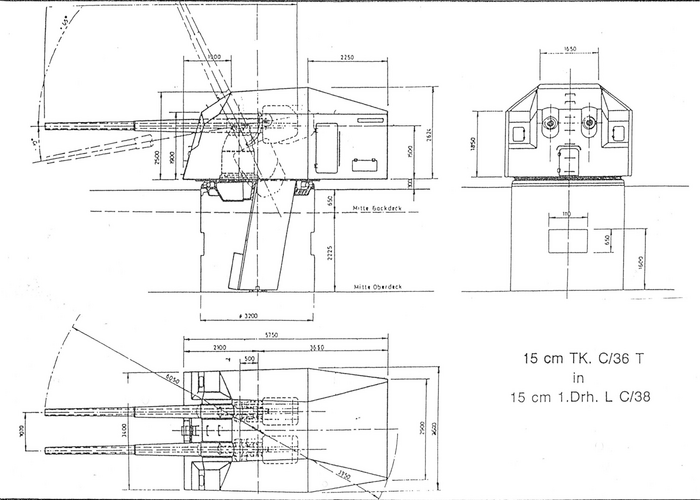
- Turrets are small enough to fit comfortably in large numbers, but not too small as to be uncomfortable to crew.
- Maximum elevation is 62 degrees. Not optimal, but adequate for AA use and an improvement over the SK C/41.
- Turrets have already entered service as of 1942 with construction of such mounts dating back to 1938.
- Existing turrets could be easily modified or turrets in production altered to better accept the 128mm/61 with no negative impact.
- Destroyers have returned to the 128mm SK C/34 or moved to the SK C/41, leaving this turret design without a priority.
- Turret is fully enclosed and largely protected from the weather.
- Powered loading is included.
- Superior ballistic performance (MV, range, etc) to other 128mm guns, and features a slightly larger bursting charge.
- The same turret was intended for use aboard the O-class battleships both at the weather deck level and a deck above.
- Training and elevation speeds are 8 degree/second, slow but equal to 10.5cm/65 C/37 mounts. This number may improve with the significantly lighter 128mm gun replacing the 15cm/48.
- A couple of (largely unsubstantiated) sources have stated it was the intention to move the 128mm/61 into this turret for testing, using guns placed around major port cities (such as Kiel).*
Cons:
- The turrets are not triaxial or (appear to be) RPC and would not make fully use of the RPC-capable triaxially stabilized SL-type directors. Perhaps the turret could be made with some amount of RPC, but that would take time and weight and would not make the guns any more triaxial.
- Possible weatherproofing problems by placing them at the weather deck level, especially bad on low-sitting ships such as the Scharnhorst-class. Weight removed by the use of 128mm will necessarily be eaten away at by additional weatherproofing.
- Ammunition supply rate is far too slow at just 8 rounds per minute per barrel, necessitating an improved ammunition elevator such as that of the Drhl. C/41 (15 rounds/minute/gun electric-driven) eating again away at saved weight and taking time.
As you can see, the Pros certainly outweigh the Cons, much more so than the 128mm SK C/41 used in the Breyer Proposal, and even the Cons are not things that cannot be overcome with some minor edits (with the exception of triaxial stability or the making of holes in the decks). Even if the weight savings obtained by using the KM40 over the 15cm/48 TK C/36 (Drhl. C/38 w/ KM40 = 52.87t vs 60.4t with 15cm/48) was eaten up entirely, one could still replace the entire secondary battery 1-for-1 and still only break even.
In conclusion: It is the perfect design for the Kriegsmarine in a pinch if they got their hands on the F.Z. 40 for Gneisenau, according to plan - "Kriegsmarine in a pinch" pretty much describing the KM ever since the war broke out. Out of all the turret and gun options, it is the most rapidly sourced among them, requiring only minor modification, already in production, and all-around well-suited for DPAA work as a secondary weapon compared to the 128mm SK C/41.
For the Kriegsmarine, it's all about what could be sourced quickly - there's a war on (or if 1938/39, would be very soon), and you have to use what you have, even if it isn't the best thing. Sometimes that begets creative and otherwise unorthodox solutions, but it generally will consist of things already in production. You will see this reflected in almost every German design from 1938 and on and is just part of the nature of the beast. So, as odd as it might sound, WG nailed their Gneisenau secondary battery refit on the head - and it looks good to boot.
But it's not the most optimal choice.
So what does the most "optimal" possible secondary refit look like? Here's my suggestion:
The Sarcasticat Proposal
A few of you probably already know where this is heading, but still, let's discuss.
So if the 12.8cm SK C/41 and Drhl. C/41 and the Drhl. C/38 turret are out of the picture for the F.Z. 40, what's left?
Well, during mid-to-late 1940 and early 1941 there was a series of high-elevation triaxial enclosed turret designs (read: big 10.5cm twin mount) for a "12.7cm Doppelflak L54". Upon closer inspection, it is obvious this is just a shorter 128mm Flakzwilling 40. Whether this is because the KM expected to shorten the 61-caliber barrel to reduce weight (most likely) or because at this time the length of the barrel has not been determined (less likely), it is still clear to see that, with the issue of production not forthcoming at the time, the KM figured that it would have access to a larger number of the 'intermediate caliber' weapons that underwent testing in 1938 and was nearing its final form in late 1940 and as such made a series of pre-emptive designs for twin turrets.
The name of these designs is unknown, but "LM40" is already taken, haven been given to the coastal mounts. Given the date of the final design we have being very early 1941, a prospective name might be "LM41". The guns had an elevation of +85 deg and could depress -10 deg, but other specifications (such as elevation/training speeds, weight, etc) are not known or were not created. However, one can guess that the weapon would be immensely weighty - upwards of 60t with train and elevation speeds somewhere in the ballpark of 10 deg/s. This is a design meant as a large secondary weapon.
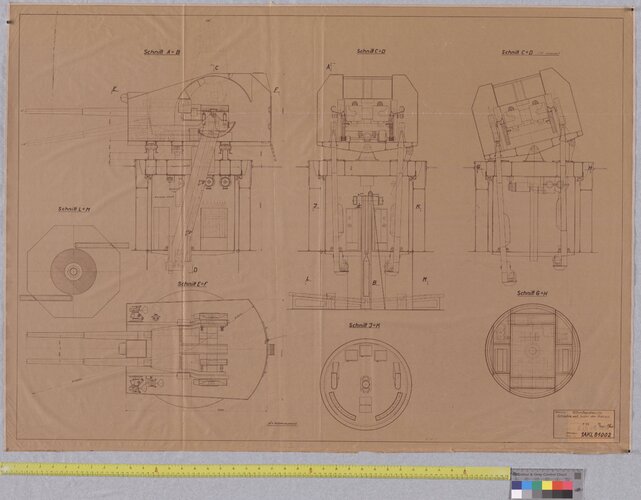
The final rendition of the 12.7cm Doppelflak twin turret design, 22 January 1941. For those of you who find this turret familiar, you can find it on some high-tier German ships in WoWs (Preussen, Clausewitz, and Hannover, for example).
For Gneisenau this is about the best that would ever possibly be available - that we currently know of - and despite the unfavorable weight estimate the ship could still handle a 1-for-1 swap and break even with the original 15cm/10.5cm battery weight.
Let's discuss the Pros and Cons:
Pros:
- Turret is slightly larger than the Drhl. C/38 (5.78m long x 3.4m wide for C/38 / 5.6m long x 4.0m wide for LM40)
- Maximum elevation is 85 degrees, perfect for AA work.
- Turret is fully enclosed and protected from the weather.
- Powered loading is included.
- Superior ballistic performance (MV, range, etc) to other 128mm guns, and features a slightly larger bursting charge.
- Gun is triaxial and no doubt will have RPC capabilities, making the most use of pre-existing SL directors.
- A lot of information is unknown, which makes it difficult to quantify how good or bad it truly is.
- Most likely of all turret options to suffer at weather deck level from waves and sea spray (corrosion, electrical faults, damage, etc).*
- Unsure if the design work has been completed, production is nowhere near beginning, and no prototypes exist, although it appears that there were efforts underway late in the war to get a turret like this, known as the 'Dopp Flak LM44', going.
- An extremely complex and delicate-looking mount which may take significant R&D time unless heavily prioritized.
As you can see there isn't a lot to write about because there isn't much that is known. In theory, if this is just an enlarged version of the 10.5cm with some additional features, one might expect to see similar levels of armor, comparable train and elevation rates (at least to the 10.5cm C/38 mount), and overall good performance - just at a larger scale. The main issue comes with production, but at least the design dates to 1940 (or latest known, Jan. 1941) which means that it has at least reached paper in a detailed form even if no prototype turrets were made (to our knowledge). However, there is no getting around this production issue (prototyping, tooling, etc) unless the turret has priority and it is certain the KM can attain the F.Z. 40 to mount to it, leaving this proposal dead last in terms of production potential - even the 128mm SK C/41 is slightly ahead due to finalized turret design, mount prototype, the like.
In conclusion: It's the most optimal and reasonable turret for the job, it just needs to get produced. But for 1942-going-on-43 Germany, that's quite a tall order, even if it was as simple as "make 10.5cm - but bigger".
Conclusion.
Some people on the internet say that the Drhl. C/38 turret is intended to be the stopgap measure until the triaxial mount ("LM40") (or perhaps LM44) could be produced, which, regardless of truth, makes the most sense when you think about it. In 1943 the C/38 is the only available HA turret or mount of any type that the Kriegsmarine has in production that could take the 12.8cm F.Z. 40/KM40 if they were to receive a batch that year. With the war tipping out of their favor and the disastrous Battle of the Barents Sea (31 Dec 1942) causing Hitler to call for a complete removal of all his capital ships (from existence), it suddenly becomes that much harder to substantiate the worth of getting such a complex turret as the "LM41"/LM44 on short notice. This is probably why only design work was underway when the war ended.
So in short that leaves us with this conclusion: The "LM41" is the most optimal turret, the C/38 is the most realistic and practical, and the SK C/41 is the choice the KM would make if they couldn't get their hands on the Flakzwilling 40 but still wanted to proceed with a secondary battery change.
But I guess K235/N4 trumps all of them because it's the only drawing we have on paper.
Well, maybe there are more drawings of proposed secondary battery changes, or more discussions in books somewhere, but we don't have those yet. Maybe one day.
Whew, another full day taken to revise this! Hope someone learned something.
Last edited:

